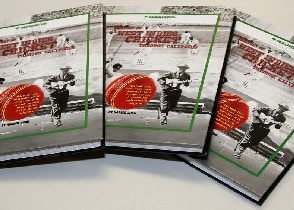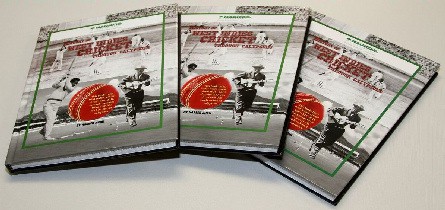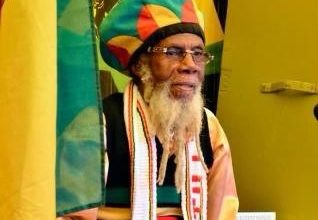Calypso and cricket inseparable umbilical cord of Caribbean Cricket

By Prof Ravi Chaturvedi
TORONTO, Canada – Calypso was a nymph in Greek mythology, who lived on the island of Ogygia, where she detained Odysseus for seven years. Calypso generally said to be the daughter of the Titan Atlas and Pleione.
But in the game of cricket calypso is amalgamation of music and poetry. It romanticizes the sport and its culture. Each calypso composition is unique and means differently to the followers of the game during a particular period of time.
Author has been to Caribbean to cover cricket more than half dozen times. He has found that the cricket venues at Trinidad’s Queen’s Park Oval and Jamaica’s Sabina Park offer unique ambience and atmosphere that pervades only in the Caribbean cricket centers.
The musical Calypso and soca accompanied by conches, bands, bugles and trumpets may be raucous yet an enjoyable cacophony.
The cricket world outside the Caribbean came to know of calypso when West Indies defeated England on the sanctum sanctorum of cricket, The Lord’s in 1950.
Lord Kitchener (real name Aldwyn Roberts) composed a song -‘With those two little pals of mine Ramadhin and Valentine’, sung by Egbert Moore (pseudonym Lord Beginner) to celebrate the maiden Test triumph over the Blighties.
In 1971, when Sunil Gavaskar made a sensational debut and India recorded its first ever win in the West Indies, Lord Relator (actual name Willard Harris) wrote the Gavaskar calypso wherein he describes how Indian maestro batted like a wall. But the doyen among cricket writers Neville Cardus as early as 1930 while highlighting the role of calypso in cricket wrote, “And so cricket and calypso became part and parcel of Caribbean cricket tradition…”.
But a freelance Trinidadian journalist Nasser Khan for whom cricket and calypso are his greatest passion. He embarked upon a momentous mission to compile a compendium, entitled History of West Indies Cricket Through Calypsoes (from 1928 to 2016).
 The book is a store house of information on antiquity that portrays the history of West Indies Cricket through popular Caribbean music known in local parlance the calypso. It is a musical recapitulation of deeds from Constantine and Headley to the three W’s and Ramadhin and Valentine to Sobers, Lloyd, Richards and Lara.
The book is a store house of information on antiquity that portrays the history of West Indies Cricket through popular Caribbean music known in local parlance the calypso. It is a musical recapitulation of deeds from Constantine and Headley to the three W’s and Ramadhin and Valentine to Sobers, Lloyd, Richards and Lara.
The contribution of many legends and winning teams are immortalised through calypso songs. The two-time record breaking feats of Brian Lara create immortality in the words of calypso-‘Signal to Lara’. In fact, Lara himself pointed out the significance of calypso“.
Nasser rightly wrote, “Cricket and calypso are the two areas of our regional life and culture that go hand in hand and bind us together like nothing else does. So intertwined were calypso and cricket at every turn, it became natural to refer to our cricket as ‘calypso cricket’ and our cricketers as ‘calypso cricketers’.”
In fact, calypso and cricket marriage took place much before West Indies became a Test cricket playing team. Nasser’s research reveals, “…there are the lyrics from a calypso sung by famous calypsonian Atilla the Hun at a calypso ‘tent’ when a MCC team was on a private tour of the Caribbean.
Actually, there is an ill-fated calypso on the West Indies politics. After gaining independence in 1958, the islands formed a West Indies Federation but it soon broke up into self-governed islands in 1962. Relevant calypso has captured the moments of the disintegrating political entities.
During eighty years of its cricket’s existence when West Indies joined the elite, cosy, comfortable cricket club of England, Australia and South Africa in 1928, the historical moments (joining ICC) of the Caribbean cricket have been expressed through calypso music and songs.
Nasser has highlighted the role of calypso and cricket in his book, “Cricket continues to be inspiration for many a calypso as the art form has chronicled the ups and downs of the game in Caribbean. Cricket and calypso have caused more celebration and condemnation, more scorn and praise, than anything else.”
There are ten national anthems and ten prime ministers but only one cricket team-West Indies. Nasser is on same wavelength when he writes, “Cricket is our identity, a rallying point of togetherness and putting aside of our differences to be under one banner, THE WEST INDIES. The rallying cry for unity is done in many instances through the medium of cricket calypsos.”
History of West Indies Cricket Through Calypsoes is a well-researched and racy portrayal of cricket, poetry and music.
Kudos to Nasser for bringing out an excellent and exclusive book that traces the troughs and crests of the West Indies cricket through the medium of lyrics numbering nearly 200 cricket-themed calypsos. The 211 paged publication is well illustrated through pictorially supported action and events highlighted by the actual lines of the poem dealing with the theme. It will be a valuable collection for the lovers of the willow game.
Publication is result of love of the game of the author not meant for sale (not priced) but information about its availability can be obtained on: [email protected]
- Prof Ravi Chaturvedi is a long-time West Indies cricket fan who travels of his own to the region at the fall of a hat. For him Trinidad is his second home and out of his 23 cricket books, first was West Indies India Test Cricket, published in 1979 and contributed a chapter on Contribution of Indo-West Indian Cricketers to Caribbean Cricket in a book for international research scholars-Sojourners to Settlers-Journey to Caribbean and Americas, published by Windsor Press, NY in 2000.




